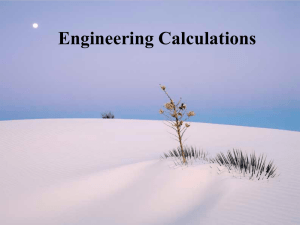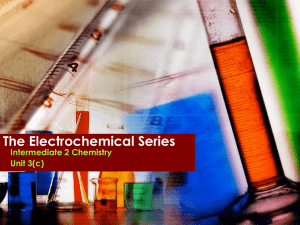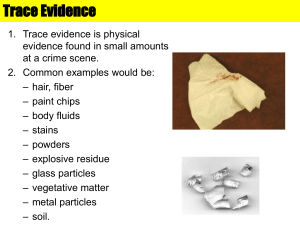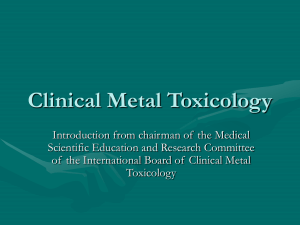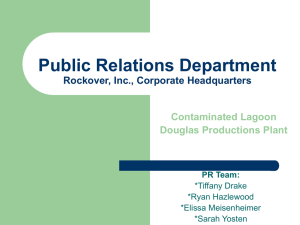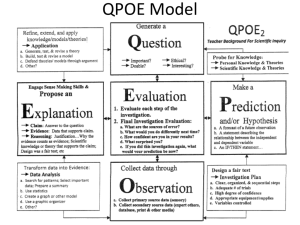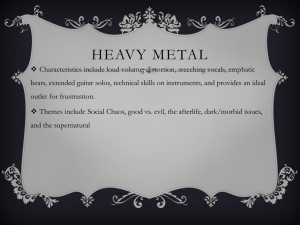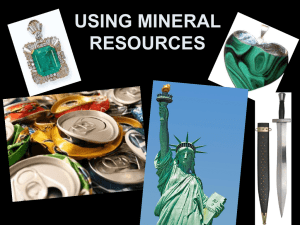JB/TL
advertisement
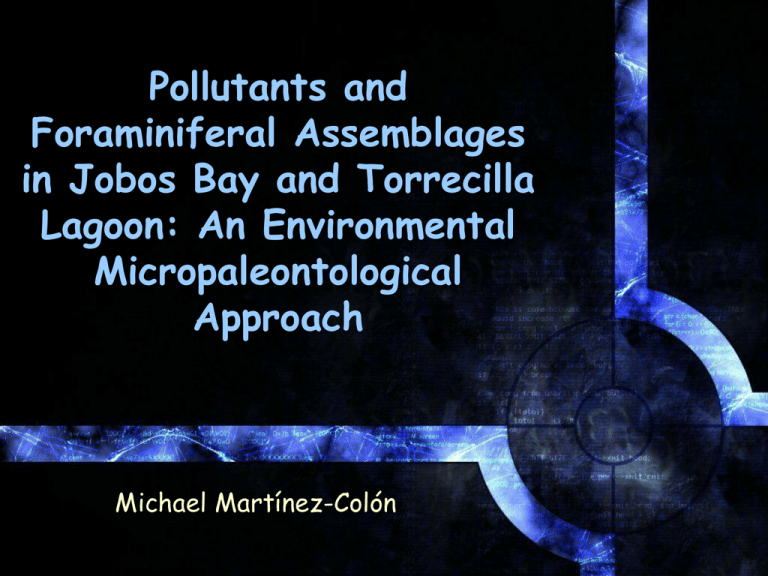
Pollutants and Foraminiferal Assemblages in Jobos Bay and Torrecilla Lagoon: An Environmental Micropaleontological Approach Michael Martínez-Colón Introduction OVER 50 YEARS IN THE MAKING… 1950 2000 Zalesny (1959) Banerji (1992) Watkins (1961) Alve (1995) Seiglie (1964, 1968) (PR) Samir et al. (2001) Seiglie (1971, 1975) (PR) Le Cadre & Debenay(2006) 2 cont… ٤ Estuaries receive 80%-90% of all waste released to marine environments, therefore are particularly vulnerable to heavy metal pollution. ٤ Effects of pollutants: water quality diseases (flora/fauna) ABNORMALITIES reduced survival rates INDIVIDUALS ABUNDANCE DIVERSITY COMMUNITIES DISTRIBUTION human disease outbreaks Why Jobos Bay (JB)? *Sanitary/fluvial discharge and illegal dumps *Raw sewage discharge *Thermal pollution from Central Aguirre *Dust Work Published Seguinot (2001) Heavy Metals Found Hg & Cu Dumas & Montalvo (2003) Pb-Fe-Cu-Zn Jimenez et al. (2003) As-Pb-Cu-Fe-Ni-V-Cd 4 Why Laguna Torrecilla (TL)? *Sanitary/fluvial discharge and illegal dumps *Raw sewage discharge *Backwash from PR-aqueduct and sewer system *Backwash Sergio Cuevas treatmentplant Work Published Webb et al. (1998) Metals Found As (17 ppm) Hg (0.05 ppm) Pb (20 ppm) 5 Purposes To re-establish the use of foraminifera as pollutant bio-indicators in Puerto Rico by understanding their inter-relationship with heavy-metals in sediments and in culture experiments. To provide a baseline assessment and characterization of the present environmental conditions at JB and TL using benthic forams. 6 Objectives to determine the distribution, bioavailability, and concentration of metals in sediments within JB and TL to determine if key identifiable foraminiferal assemblages are good tracers of pollutants on a spatial/temporal scale to determine specific morphological deformities induced by bio-available metals in controlled culture experiments 7 Study Areas ATLANTIC OCEAN TORRECILLA LAGOON Torrecilla Lagoon SUAREZ CHANNEL PINONES LAGOON BLASINA CREEK Jobos Bay 8 Preliminary Data from TL Sediments (cm) Mean grain size: mud (81%) 9 Metals 0 0.4 0.8 1.2 H(S) 0 5 10 15 20 25 30 35 40 45 Mn concentration (ppm) LOI (%) 2 4 6 8 10 12 Depth (cm) Cu values exceed the world's background values found in Shale (45ppm). 14 Carbonate Fragments 16 No Carbonate Fragmetns 18 20 22 24 26 28 30 32 Hg concentration (ppb) 0 40 80 120 160 200 240 280 320 360 400 440 Cu concentration (ppm) 10 Foraminifers < 16% deformity Mainly Triloculina spp. (98%) 11 Proposed Methodology ATLANTIC OCEAN TORRECILLA LAGOON • Surface Samples: JB- 46 TL- 15 SUAREZ CHANNEL PINONES LAGOON • Cores: JB/TL- 2/2 BLASINA CREEK • Foraminifers ~300/sample • Grain Size Jobos Bay 12 Proposed Methodology • Bulk Heavy Metal Concentration: JB/TL- 32 elements/sample; almost complete digestion; ACTLABS •Metal Bio-availability: Partial digestion using 1M HCl •Heavy Metals in foraminiferal tests: -Mn-coating removal -Ultrasonic cleaning -300 micro-gr sample size 13 Proposed Methodology • TOC: On all samples (JB/TL); Coulometric Titration method • Cs-137 and Pb-210 dating: On all sample cores; Low Energy Standard Gamma Detector •Foram cultures: Ammonia spp. Amphistegina spp. 3 replicates/experiment 20 foraminifers/microcosm 14 Proposed Data Analyses Fisher’s Index: N= # individuals S= # of spp. α= proportionality const. Shannon-Weiner Index: s N e 1 S S H(S) pi ln(pi ) pi= proportion of the i-th spp. Equitability Index: S= # of spp. H(S)= Shannon-Weiner Index E ' e H ( S) / S 15 Proposed Data Analyses Species Richness: number of species/sample. Foraminiferal Density: # individuals/gm. % Dominance: % abundance of foram species in a sample Simpson Index: measure of diversity. SHE Index: D (pi)^2 H ln( S ) ln( E ) Ammonia-Elphidium Index: [NA/(NA + NE)]*100 NA = number of Ammonia. NE = number of Elphidium. 16 Proposed Data Analyses Adsorption Coefficient: Cf ave[metal]foram / ave[metal]se dim ent Enrichment Factor: EF ([metal] /[Al])sample /([metal] /[Al])baseline EF <1 = no enrichment EF >50 = extremely severe Geo-accumulation Index: Igeo Log2[metal]sample / 1.5[metal]baseline Igeo <0 = non-contaminated Igeo >5 = highly contaminated 17 PROPOSED TIME TABLE Year 2007 Comps Field Sampling (I) Sediment/Data Processing 2008 Sediment/Data Processing Culture Exp./Data Analysis Field Sampling (II) Sediment/Data Processing 2009 Write Dissertation 1 X X X 2 X X X 3 X X X 4 5 Month 6 7 X X X X X X X X X X X X X X X X X X X X X X X X X X X X X X X X X 8 9 10 11 12 18 My thanks to: *Dr. Hallock (major advisor): for being a great mentor and for taking me under her wing *Dr. Green-Ruiz (co-major advisor): for providing guidance and feedback when I was just curious about this topic *Dr. Byrne: for your patience and insightful suggestions *Dr. Hastings: for your interest and analytical perspective *Dr. Flower: for your passion and interest in the paleoceanographic perspective of this work 19 ¿PREGUNTAS? 20
